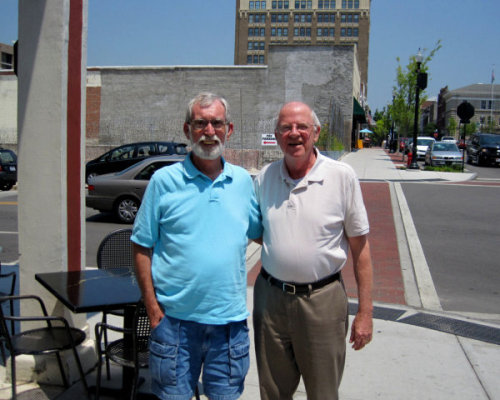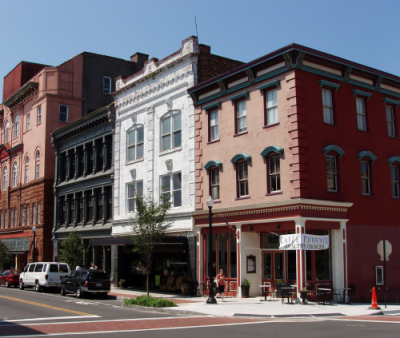|
|
|
|
Abraham David – A Jewish American immigrant
from Gimbsheim
Searching for clues in Wilmington, North
Carolina
„When they told me that they were
researching Abraham David, I became intrigued by his story. I offered to help in
any way I could. … It’s a pleasure to do this.”
Just a few months ago Don Adams from Wilmington North Carolina, could never have
imagined that one day he would become enthralled by a 150 year old story of an
immigrant from a small town in “Hesse-Darmstadt” Germany. Now, in the summer of
2011, he and his friend Roy Clifton smile into the camera for a photographic
greeting to the residents of the immigrants home town.
The two men are posing in front of one the commercial buildings built by Abraham
David the immigrant from Gimbsheim. Today, the building is owned by Roy Clifton
and is home to a café-restaurant as well as an art gallery. It is in this way
that Abraham David stands as a symbol for a small piece of shared history
between the American city on the Cape Fear River and the German village on the
Rhine.

Subheading: Don Adams (left) and Roy Clifton
That we possess material for the biography of Abraham David, is solely due to
the fact that his commercial buildings have survived the times and have a
special architectural value. It was for this reason that the preservation
society "Historic Wilmington Foundation" found interest in and dealt with the
history of the building. Nothing, however, could be found on the German side.
Not even a single hint suggested that David Abraham had emigrated at all. Only
his name and birth date were documented.
However, it is due to the research possibilities of the internet that we were
able to track down and cross reference the available information. Personal
contacts were established and the exchange of information took place. This is
why Don Adams was able to photographically document that which still bears
witness to the story of Abraham David.
From the river Rhein to Cape Fear
Abraham David was born in Gimbsheim on the 18th of June 1844 as the second son
of the merchant Jakob David and his wife Helene nee Weil, who was originally
from Mutterstadt. He had eight siblings. The family lived in Gimbsheim in the
“Untere Breiten Langgsasse – today called the “Windthorststraße”.
Abraham was 17 years old, when he embarked on his journey from Hamburg to the
United States of America together with his cousin Gabriel Haas in 1862, who was
two years older than him. (There is evidence that David travelled back to Europe
at least three times in later years. Whether one of his destinations was
Gimbsheim is not known but it is very probable. One of his journeys took place
in 1892, which was incidentally also the year in which the newly built
Gimbsheimer synagogue was inaugurated. There is evidence that his wife as well
as one of his daughters travelled to Gimbsheim in 1886 to pick up a child from
the Guthmann family.)
In America, the two young men were awaited by relatives from Eich and Hamm (neighbouring
villages of Gimbsheim) who had been living in the New World for many years and
operated their trading business in various parts of the country. When they
arrived in America the two immigrants found themselves in the midst of the
conflicts of the Civil War. Abraham first went to Philadelphia, but remained
there only a short time. He spent the remainder of the war in Alexandria,
Virginia. After the Civil War in 1885 he moved to Wilmington, North Carolina
located on the Cape Fear River. Presumably, it was the city he had intended to
go to in from the very beginning. Here he could once again count on the generous
support of relatives. After Abraham David had initially worked as a clerk for a
short time in a "dry goods store’, he established his own business – a shop for
men´s and boy´s clothing -. together with the company of his cousins in 1867.
Everything went according to plan for the immigrant from Gimbsheim. When it
became financially possible in 1867 to move from a sublet apartment into his own
house, he married Rebecca Rothschild, whom he had probably already met in
Philadelphia. Later on he and his wife had four children – three daughters and
one son. His grandchild, Edward E. David Jr. (born in 1925), is still alive
today and can look back on a distinguished career in industry and politics. In
the 1970s he was science and technology advisor to President Nixon and was,
among other things, responsible for the Apollo moon-landing program.
Abraham, David and his family were very much involved in civic and religious
life in Wilmington and held various positions in a variety of charitable
associations and organizations especially in the Jewish community of the city.
In 1870 David opened a second shop for men's clothing together with another
German immigrant (probably a relative on his mother’s side). This shop also
served as his residence. After the partnership was dissolved by his partner´s
move north in 1877 he relocated his business to a separate building. Seven years
later, in 1884, Abraham David moved again this time into a building which was
built especially for his clothing company located at North Front Street, a
prominent shopping street that runs parallel to the Cape Fear River and is
located near the harbor.
His story of success was, however, not yet finished. In 1899 the businessman
founded the „A. David Company“over which he presided as president until his
death in 1914.
His son Edward served as vice president and one of his sons in law held the post
of financial secretary. Under their joint leadership, the company became one of
"the best stores in the Carolinas, if not throughout the South“, as was once
appreciatively determined by the local press. At the beginning of the new
century David Abraham built a second, even more representative shop, which was
also located on North Front Street and occupied by his company in 1908.
Abraham David carried an extensive range of goods in his store, encompassing a
wide selection, from simple work clothes to the best quality garments and
decorative items such as hats, collars, ties, etc. One could even purchase the
newly crafted Jeans by Levi Strauss and the tailor Jacob Davis. The ingenious
merchant also manufactured uniforms for Wilmington´s police department. The
men's tailoring business offered customers the "finest domestic and foreign
fabrics” designed individually, "in the latest fashion and fit at very
reasonable prices." The business of more than 10 employees operated both retail
and wholesale trade and supplied small retail shops in the region via its own
representatives or by postal order.
Abraham David passed away on the 12th of July and with him, according to an
obituary, "one of the most famous entrepreneurs of the city."
For a short while after his death the business was continued by the remaining
partners. However, the building and complete selection of goods was sold to a
nationwide department store. The department store existed until 1953. Abraham´s
son, Edward E. David, had moved with his family to Atlanta, where they met the
second generation of their relatives and other immigrants from Gimbsheim, Hamm
and other places in Rheinhessen.
The A.David Company itself was officialy dissolved in 1933.
Searching for clues in Wilmington
Wilmington is one of the most historic places in North Carolina. The city on the
East Coast was founded in 1739 and was a major seaport and industrial center
well into the 20th Century. In Abraham David’s time the city had 15.000 to
20.000 inhabitants (today there are more than 100.000). Wilmington was largely
spared from destruction during the Civil War. While disasters such as fires or
building demolitions have wounded the city, the historical section of Wilmington
remained largely intact.
The "Historic Wilmington Foundation" takes care of the preservation and
restoration of historic buildings. The two A.David Company buildings were also
included in the conservation program because of their historical and
architectural features.
Thus, for example previous renovations with modern paneling were removed and the
façade was restored to its original state. Meanwhile, one of these buildings has
even become a stop on a tourist city tour.
A. David 35 Front Street
The three-storey building on North Front Street / corner of Princess Street was
built in the so-called "Italienate style." This classically influenced style was
indeed a popular architectural style in the U.S. between 1850-1880. In the
poorer southern states, however, this style was encountered less frequently. To
this extent, the A.David building is of great importance for the architectural
history of Wilmington. Today it is home to the “Café Phoenix”.

A. David 228 North Front Street
The building stretches from 13 m in width to 38m in depth. The jutting glass
front, the balcony and the flat-glass window, was not only very attractive to
look at but also quite functional, because it permitted excellent lighting of
the displayed merchandise. And from the upper floors of the building one had a
magnificent view of the Cape Fear River. Today it serves as a prestigious office
address.
Sadly, Abraham David’s private homes no longer exist. One of them was designed
by the renowned architect Charles McMillen. However, the attractive house on
South Fifth Road 111 built by his son Edward E. David has remained intact. It is
a two-story brick building with a raised terrace on the front side that is
supported by brick pillars and enclosed by a rectangular wooden balustrade with
square cutouts. The building is crowned by a so-called "Flemish gable." The
house is privately owned.
Unfortunately, despite intensive search, no photographs of Abraham David could
be found. So in the end as it was in the beginning we are left only with a date
on a document: his grave stone, photographed by Don Adams in Wilmington’s Jewish
cemetery “Oakdale Cemetery”.
Bibliography
The above article is a work in progress report which refers to the current state
of research for a book project. The book is set to appear in mid-2012 and will
be published by the Kehl publishing house in Hamm. Herein, the history of the
emigrant of Gimbsheim David Abraham will be told with numerous illustrations and
original documents. A digression on the German-Jewish Wilmington, written by
Anton Hieke from the Center for U.S. Studies at Martin-Luther-University
Halle-Wittenberg, rounds off the plot.
The current collection draws on material from the following sources:
-Copies of historical newspaper articles and other documents from the "New
Hanover County Public Library", Wilmington
-Digitized documents from Internet portals nhcgov.com,capefearmuseum.com,
ellisisland.org, ancestry.com, footnote.co.
- Current information and illustrations on the topic can be found at
erich-graf.de.
Further unpublished archival material for the book publication will be evaluated
on site in Wilmington.
Print material that has been consulted so far is
- Günter Reich: Die Juden in den Orten der Verbandsgemeinde Eich/Rhh. In:
Hessische Familienkunde Bd. 29.2006, Sp. 165ff und Bd. 30.2007, Sp. 79ff und Sp.
129ff.
- Directory City of Wilmington North Carolina, 1867 ff
an Literatur:
- Manfred Janß: Die Erfüllung des amerikanischen Traums. In: Wormser Zeitung“
vom 23.4.2011
- Susan Taylor Block: Cape Fear Lost, 1999
- Jens Bodamer: Deutsche Auswanderer in den Vereinigten Staaten von Amerika, am
Beispiel einer Kleinstadt Wilmington, North Carolina, Norderstedt 2009 und
- Helmut Schmahl: Verpflanzt, aber nicht entwurzelt: Die Auswanderung aus
Hessen-Darmstadt (Provinz Rheinhessen) nach Wisconsin im 19. Jahrhundert,
Frankfurt a.M. 2000.
Home
|
 |
 |